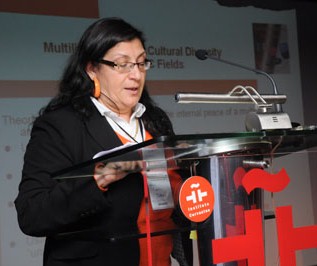By Afsar Soheila Sattari, Goal- Electronic Print Media & Training Services, Cologne
Note: This paper was presented at International Conference "Role of Translation in National Building and Supra Nationalism" held on December 16-19, 2010 at Instituto Cervantes, New Delhi and forms part of the digital book Theoretical and Empirical approaches to translation, Published by Modlingua, New Delhi
There are persons, social groups and institutions, who clearly defend “naturalism1”, meaning that the human being has a relatively fixed nature and that culture is a phenomenon to ascertain the validity of one way of life. On the contrary, there are others, who defend "culturalism", which asserts a minimal set of social and cultural common features among different people and points out that the leaders and successful individuals of a society should own a pluralist perspective to manage the on-going procedures and emphasize on the necessity of providing a dialogue on cultural differences to guarantee a peaceful co-existence.
“UNESCO published a report2 describing that over 50% of the world’s languages are endangered by the great ones. 96% of the 6000 languages are spoken by only 4% of the population of the world, 90% of the world’s languages are not represented on the internet, one language disappears on average every two weeks and 80% of the African languages have no orthography.” On the other hand, English is spoken by around 500 million speakers throughout the five continents, Spanish is spoken by approximately 400 million speakers in more than 20 countries. Portuguese is spoken by 230 million people in Africa and Europe, as well as French, which is the mother tongue for almost 190000 people worldwide.
The speakers of every one of these languages are scattered in different countries and live in the extremely diverse, multilingual and multicultural societies and have to adopt themselves and co-exist with others. So far, cultural diversity can be an origin of social conflict by remaining unattended. To prevent that, the leaders should try to find solutions to turn racial, religious and tribal differences into strength.
The problem of establishing a successful multicultural society is not new. For instance in the multi-ethnic, multi-lingual, multi-religious and multi-cultural society of India there were two leaders3 , King Ashoka and Emperor Akbar, who established an atmosphere of dialogue based on the trial and error system to deal with differences and developed public discussions among 13 faiths of India to make social progress. The on-going procedures in multicultural societies like Canada, India and The Netherlands certify that a modern state needs to view itself in order to deal with the facts of cultural diversity to be able to keep the unity of multicultural society and “the sense of belonging” among its population.
Globalization has created a trend towards “surface internationalism”, by means of finding the same services like business hotels or McDonald´s worldwide. On the other hand the raise of the phenomenon “integrated marginals4” within the globalization procedure clarifies the ability of the “third-culture kids” or the “xth generation of immigrants”, who feel comfortable in diverse environments and contribute to cross-cultural and international success. They perceive more implicit cultural elements, hidden assumptions and a kind of deeper level of culture and are able to shift from one cultural viewpoint to another by accepting the appliance of both views and work “within the systems” without being trapped by them.
Nowadays the theory that cultural diversity could best be accommodated by leaving cultural minorities free to continue their own way of lives imposed by a common framework of laws, is rejected by many political theorists due to its failure in delivering either liberty or equal treatment to them. Some current liberal theories of justice and multiculturalism eliminate the interests of those who do not believe in Western ideas of the individual and the self or way of life. By recognizing the group identities, other theorists propose granting them exemptions from certain laws, verifying their values publicly and providing them with special privileges as a better way to keep the internal peace of a multicultural and ethnic society, i.e. using “acceptable solutions” to solve the conflicts arising from the “unacceptable traditions”. The end result to achieve is mutual respect.
Different cultural communities use differing logics when solving problems or managing human relations, so reconciliation and deducing the internal logic behind an individual’s way of thinking is the only key of solution. Cultural differences might be dealt with the help of these three challenges:5 a) resistance, b) acceptance, and c) adaptation. Resistance implies that the difference is perceived as a threat. Acceptance implies recognition of the fact that the difference we experience represents a valid alternative way of looking at or doing things. Adaptation means that we learn new things and take on new behaviours to better match our new environment. The key to develop deep cultural empathy is taking distance of resistance and moving towards acceptance and adaptation in the long run.
Sharing knowledge in a firm is a value even higher than encouraging collaboration and should be made possible because of diversity of perspectives, appreciation of the diverse backgrounds and by hardware and software mechanisms. To facilitate the interconnection of group members, we have to perceive their philosophical backgrounds and values such as obedience, loyalty, attitude, traditional etiquette and ethics, welfare of the group and social environment, weight of individualism and independence or collectiveness, hierarchy and prestige, importance of integrity and implicit trust and honour between managers and employees, human factor and friendliness. Furthermore the nonverbal, body language and its interpretation should also be kept in mind. The quality of such recognition to each other can build a solid foundation of trust within the enterprise to facilitate collaboration.
The success of communication in the international virtual office is closely related to linguistic, cultural, legal and technical factors. IBM, GE and Unilever, as successful global companies, take the cultural diversity in account as one of their most important success factors. Mirroring the world diversity in their personnel structure is their task, which enables them to understand the needs of present and potential customers better by getting new innovative ideas for the markets from these colleagues, what for them has meant the transfer of multi-culturalism into wealth, comparing with the monocultural companies.
The Lewis-model6 offers training and consultancy for enabling the intercultural collaborations. It classifies people in three main categories in accordance with their cultural profile: a) the linear-active types: task oriented, highly organized and on time planners, following a linear agenda [Germans, Swiss, US American and British], b) the multi-active types: emotional, loquacious, impulsive people, do many things at the same time and are poor followers of agendas [e.g. Argentineans, Brazilians, Italians, Mexicans and Spaniards] and c) the reactive types: introverted, respect-oriented, accommodating listeners who tolerate silence as well [e.g. Vietnamese, Japanese and Chinese].
Having success in diverse environments and achieving a deep cultural empathy could also be trained, for instance by using the Intercultural Development Inventory (IDI) tool7, which is a psychometric instrument to give feedback on one’s stage of intercultural development, or by using PICO (Personal Intercultural Change Orientation)8, which helps learners understand how best to develop this cultural empathy in diverse environments.
In the field of Technical Communication (TC) many tools are developed to ascertain going global and multilingualism. Such firms could save 20% or even more in localization costs by internationalizing their product and entering the foreign markets, i.e. by making the documentation design able to handle multiple languages, cultural conventions and local infrastructures without the need for a re-design. On the other hand, the translators need to know, where their target audience in different continents live, while choosing the appropriate terminological and orthographical terms (e.g. Brazilian Portuguese or the Portugal Portuguese by translating a Portuguese text). Using XML to separate the content from format and to describe the content with structure and attributes enables TC companies to share and reuse a globalized content, to publish that to multiple formats (for online help and PDF manuals) and reduce the translation costs. As the next facility tool to promote multilingualism is subscribing to a globalization management workflow service via SaaS model9, which lets globalization teams benefit from Terminology Management (TM) centralization with multiple language service providers connecting to the system, without having to install it by oneself. HyperTerm10 is another Web-based application and multilingual terminology management system, which allows an organisation to share its corporate terminology with internal users, as well as with suppliers or contractors outside the organisation. Furthermore some database publishing systems provide a matrix screen to select a document from different languages or from all the languages by choosing the Multi option (mostly the European ones).
To rescue the 6000 above mentioned endangered languages, due to the lack of a professional or technical vocabulary und being forced to use English terms instead, as in Slovak in IT, automobile, medicine and legal fields, UNESCO published “Guidelines for Terminology Policies”11. The Catalan terminology centre (Termcat) offered a Software as well, which accepts the multilingual challenge as the fundamental principle, grants the same rights to every speaker und promotes multilingual work globally. In some countries, law and state authorities support the correctness and appliance of technical regulations and documents. For instance the “Commission for Terminology of the Latvian Academy of Sciences” in Latvian or the “Central Service Centre for German Translations” or the “State Language Centre” belonging to the Ministry of Justice in Belgium, resulting to a regulation about making all the documents be available in their three official languages, Dutch, English and French.
Although one could observe the growing acceptance towards diversified collaboration during the last few years, there is still a long way to go. There’s a need for breathing in an atmosphere, which allows the self-reflection and critical examination of adopted management models. The development of organizational ideologies based on cognitive structures which are culturally sensitized to diversity plays a strategic role through proper management of our culturally diversified globalized economy.
ISBN: 0-674-00436-1, UK, 2000
4 + 5) The multiculturalist - beyond one single perspective, Joseph Shaules
http://www.tekom.de/index_neu.jsp?url=/servlet/ControllerGUI?action=voll&id=2760
6) Integrating culture and knowledge into the corporate structure
http://www.tekom.de/index_neu.jsp?url=/servlet/ControllerGUI?action=voll&id=2330
7 + 8) The same as 4)
9) Act Small, Globalize Big, Jessica Roland, tcworld Feb. 2008, Page 14
http://www.tekom.de/index_neu.jsp?url=/servlet/ControllerGUI?action=voll&id=2392
10) http://www.tedopres.nl/hyperterm-terminology-management
11) The same as 2)
ISBN: 0-674-00436-1, UK, 2000
ISSN: 1381-4338
ISBN: 3-00-013134-5






